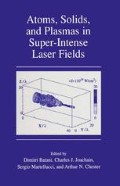Abstract
In recent years very high intensity short-pulse lasers with high repitition rates have been available in the laboratories. This has led to investigations of laser-atom interaction processes at hitherto unaccessable domains of double ionization signals vs. field intensity. Furthermore, new detection techniques have opend up the possibility of measurements of momentum distributions of the emitted electrons and ions in coincidence. Thus, for example, double ionization yields of He atom interacting with intense short pulse lasers have been measured (e.g., [1, 2, 3, 4, 5, 6]). More recently the momentum distributions of the two electrons emitted in double ionization of noble gas atoms have been determined via the measurement of the recoil momentum of the doubly charged ions in coincidence with an electron [7, 8]. These results provide important new tests of the mechanism of double ionization process in intense ultrashort laser pulses.
Access this chapter
Tax calculation will be finalised at checkout
Purchases are for personal use only
Preview
Unable to display preview. Download preview PDF.
References
D. N. Fittinghoff et al., Phys. Rev. Lett.69, 2642 (1992).
B. Walker et al., Phys. Rev. A48, R894 (1993).
K. Kondo et al., Phys. Rev. A48, R253l (1993).
D. N. Fittinghoff et al., Phys. Rev. A49, 2174 (1994).
B. Walker et al., Phys. Rev. Lett.73,1227 (1994).
S. Augst et al., Phys. Rev. A52, R917 (1995);
A. Talebpour et al., J. Phys. B30, 1721 (1997).
Weber et al. Phys.Rev.Lett84, 443 (2000).
Moshammer et al. Phys.Rev.Lett84, 447 (2000).
F.H.M. Faisal and A. Becker, inSelected Topics on Electron Physics, Eds., D.H. Campbell an H. Kleinpoppen, Plenum Press: N.Y. (1996), p. 317.
A. Becker and F.H.M. Faisal, J.Phys. B29, L197 (1996);ibid 32,L225 (1999).
F. H. M. Faisal and A. Becker, Laser Phys.7, 684 (1997); in
Multiphoton Processes 1996, ed. by P. Lambropoulos and H. Walther, Int. Nat. Conf. Ser. No. 154 (IOP: Bristol, 1997) p. 118.
A.Becker and F.H.M. Faisal, Phys.Rev. A59, R1742 (1999); ibid A59, R3182 (1999).
A.Becker and F.H.M. Faisal, Phys.Rev.Lett84, 3546 (2000).
J.S. Parker, K.T. Taylor, C.W. Clark and S. Blodgett-Ford, J. Phys. B29, L33 (1996);
E.S. Smyth, J.S. Parker and K.T. Taylor, Comp. Phys. Comm. 144,1 (1998).
F.H.M. Faisal,Theory of Multiphoton Processes, Plenum Press, N.Y. (1987).
F.H.M. Faisal, Phy. Lett., A 187,180 (1994).
A. Becker and F.H.M. Faisal, Phys.Rev. A50, 3256 (1994).
C. Joachain,Qunatum Collision Theory, 3rd. edn., North-Holland, Amsterdam (1983).
H. R. Reiss, Phys. Rev. A22, 1786 (1980).
L. V. Keldysh, Zh. Eksp. Teor. Fiz.47, 1945 (1964)
L. V. KeldyshSov. Phys. JETP20, 1307 (1965)];
F. H. M. Faisal, J. Phys. B6, L89 (1973);
F.H.M. Faisal, A. Becker and J. Muth-Böhm, Laser Phys.9, 115 (1999).
P. Corkum, Phys. Rev. Lett.,71, 1994 (1993).
A. Erdélyi (Ed.),Higher Transcendental Functions, Vol. 2, (New York: McGraw-Hill, 1953).
The uncertainty in the intensity measurement is ≈ 15 - 30%, and that of momentum resolution ≈ 0.2 - 0.4 a.u. [R. Dörner H. Rottke (private communication)].
Author information
Authors and Affiliations
Editor information
Editors and Affiliations
Rights and permissions
Copyright information
© 2001 Springer Science+Business Media New York
About this chapter
Cite this chapter
Faisal, F.H.M. (2001). Intense-Field Many-Body S-Matrix Theory: Application to Recoil-Momentum Distributions for Laser-Induced Double Ionization. In: Batani, D., Joachain, C.J., Martellucci, S., Chester, A.N. (eds) Atoms, Solids, and Plasmas in Super-Intense Laser Fields. Springer, Boston, MA. https://doi.org/10.1007/978-1-4615-1351-3_13
Download citation
DOI: https://doi.org/10.1007/978-1-4615-1351-3_13
Publisher Name: Springer, Boston, MA
Print ISBN: 978-1-4613-5511-3
Online ISBN: 978-1-4615-1351-3
eBook Packages: Springer Book Archive

